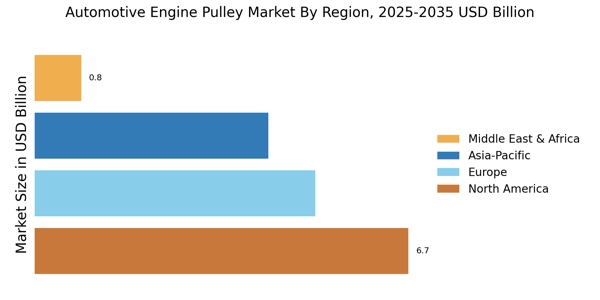Expansion of Aftermarket Services
The Automotive Engine Pulley Market is witnessing a significant expansion in aftermarket services, which is contributing to its growth. As vehicles age, the demand for replacement parts, including engine pulleys, increases. The aftermarket segment is projected to grow at a compound annual growth rate of approximately 5% over the next few years. This growth is driven by the rising number of vehicles on the road and the increasing awareness among consumers regarding vehicle maintenance. Additionally, the availability of a wide range of aftermarket pulleys, including performance and OEM options, enhances consumer choice. This trend suggests that the Automotive Engine Pulley Market will continue to thrive as more consumers seek reliable replacement parts to ensure optimal engine performance.
Rising Demand for Fuel Efficiency
The Automotive Engine Pulley Market is significantly impacted by the rising demand for fuel efficiency among consumers and manufacturers alike. As fuel prices fluctuate and environmental concerns grow, there is an increasing emphasis on developing engines that maximize fuel economy. Engine pulleys play a crucial role in optimizing engine performance and efficiency. Manufacturers are focusing on producing lightweight and high-performance pulleys that contribute to overall vehicle fuel efficiency. Recent studies indicate that vehicles equipped with advanced engine pulleys can achieve up to 10% better fuel economy. This trend is likely to drive innovation within the Automotive Engine Pulley Market, as companies strive to meet consumer expectations for more efficient vehicles.
Increasing Vehicle Production Rates
The Automotive Engine Pulley Market is significantly influenced by the rising production rates of vehicles across various segments. As consumer demand for automobiles continues to grow, manufacturers are ramping up production to meet this need. According to recent data, vehicle production is projected to reach over 100 million units annually by 2026. This surge in production directly correlates with an increased demand for engine components, including pulleys. As automakers focus on enhancing their supply chains and production efficiencies, the need for high-quality, durable engine pulleys becomes paramount. This trend indicates a robust growth trajectory for the Automotive Engine Pulley Market, driven by the overall expansion of the automotive sector.
Technological Advancements in Engine Design
The Automotive Engine Pulley Market is experiencing a notable shift due to rapid technological advancements in engine design. Innovations such as variable valve timing and turbocharging are becoming increasingly prevalent, necessitating the use of advanced pulleys that can withstand higher performance demands. These advancements not only enhance engine efficiency but also improve overall vehicle performance. As manufacturers strive to meet stringent emission regulations, the demand for high-quality engine components, including pulleys, is likely to rise. The integration of smart technologies in engine systems further emphasizes the need for reliable pulleys that can support complex functionalities. Consequently, the Automotive Engine Pulley Market is poised for growth as manufacturers adapt to these technological changes.
Regulatory Compliance and Emission Standards
The Automotive Engine Pulley Market is heavily influenced by stringent regulatory compliance and emission standards imposed by governments worldwide. As regulations become more rigorous, manufacturers are compelled to develop engines that not only perform well but also adhere to environmental standards. This has led to an increased focus on the design and functionality of engine components, including pulleys. The need for pulleys that can support engines designed for lower emissions is becoming critical. Consequently, the Automotive Engine Pulley Market is likely to see a surge in demand for innovative pulley designs that facilitate compliance with these evolving standards. This regulatory landscape presents both challenges and opportunities for manufacturers in the industry.


















Leave a Comment